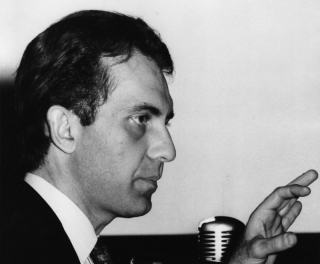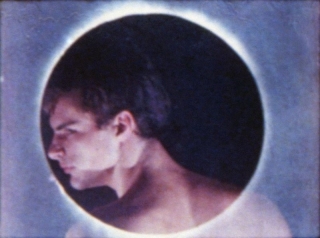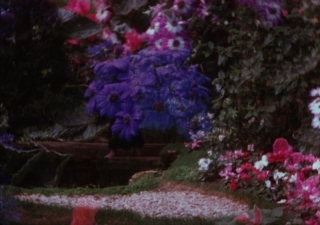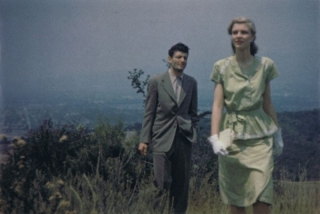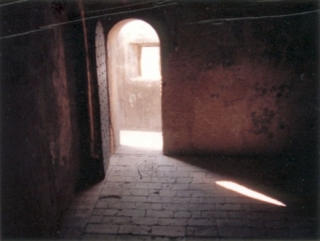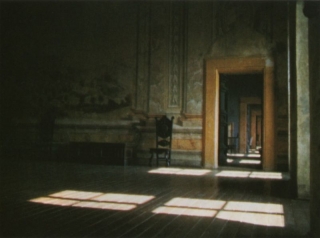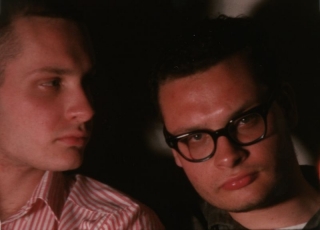Date: 29 September 2014 | Season: Gregory Markopoulos: Film as Film | Tags: Gregory Markopoulos
GREGORY MARKOPOULOS: COLLECTED WRITINGS
Monday 29 September 2014, at 7pm
New York The Kitchen
Celebrating the publication of Film as Film: The Collected Writings of Gregory J. Markopoulos (The Visible Press), filmmaker Robert Beavers, scholar Daniel Heller-Roazen, and the volume’s editor Mark Webber will lead a discussion of Markopoulos’ unique vision of film and the film spectator. Following the discussion will be a very rare screening of one reel of his magnum opus, Eniaios. This publication contains some ninety out-of-print or previously unavailable articles by the Greek-American filmmaker (1928-1992) who, as a contemporary of Kenneth Anger, Stan Brakhage and Andy Warhol, was at the forefront of a movement that established a truly independent form of cinema. Beginning with his early writings on the American avant-garde and auteurs such as Dreyer, Bresson, and Mizoguchi, it also features numerous essays on Markopoulos’ own practice, and on films by Beavers, that were circulated only in journals, self-published editions, or program notes. The texts become increasingly metaphysical and poetic as the filmmaker pursued his ideal of Temenos, an archive and screening space to be located at a remote site in the Peloponnese where his epic, final work Eniaios could be viewed in harmony with the Greek landscape.
In the last decades of his life, working quietly in Europe, Markopoulos re-edited his whole body of earlier films and dozens of new ones into one magnum opus, Eniaios. It is one of the longest films ever made: the complete film lasts approximately 80 hours and is divided into 22 cycles. From the moment he began to construct it, it was Markopoulos’ intention that Eniaios be projected only at the open-air site of what he called “The Temenos,” in a field near the village of Lyssaraia, the birthplace of his father in the Peloponnese of mainland Greece. For Eniaios, the summa of his career, Markopoulos wished to create a deeply personal and utterly unique cinematic experience. He chose the site for its natural beauty; he had conceived the Temenos as a viewing space where the physical environment would be in harmony with his idea of cinema as an instrument of philosophical and psychological revelation. In calling his projection space “The Temenos,” the filmmaker was invoking the religious traditions of ancient Greece, where a portion of land was set aside for the ritual worship of a god. The original meaning of the term “Temenos” is “a piece of land set apart.” Markopoulos wanted his life work shown in a space “set apart,” when after years of working in the international arena of the experimental film, he grew disillusioned with the interrelated commercialism of the film industry, the universities, and the art museums. He was convinced that the grandeur of what he called “film as film” required something radically different.
Gregory Markopoulos: The Collected Writings is made possible with support from Axe-Houghton Foundation and Lambent Foundation Fund of Tides Foundation, and in part by public funds from New York City Department of Cultural Affairs in partnership with the City Council and New York State Council on the Arts with the support of Governor Andrew Cuomo and the New York State Legislature.
Date: 5 October 2014 | Season: Gregory Markopoulos: Film as Film | Tags: Gregory Markopoulos
FILM AS FILM: THE CINEMA OF GREGORY MARKOPOULOS 6
Sunday 5 October 2014, at 7pm
Cambridge Harvard Film Archive
Gregory J. Markopoulos, Hagiographia II, 1970/1989-91, 60 min
Past the gates of the Temenos, and upon the twin hills the film spectator of the future will encounter the immeasurable works of Beavers and Markopoulos. On one hill will be the space of Beavers. On another hill there will be the space of Markopoulos. Here the film spectator of the future will devote himself to eternity, to the works of Beavers, to the works of Markopoulos. The spectres of distribution will have been vanquished; the spectres of projection will have been vanquished; the spectres of printing will have been vanquished. The patron of the Temenos will be he who is also unknown; hewho is without gifts of any kind; he who will be as immortal as the works being presented; he who will recognize that of all the arts only film needs a space in which to be seen; the rest is all artificial: museums, theatres and such. Only in the heart of the Peloponnesus, in Pelop’s land will film culture survive enhanced by the spirit of a truly simple and free people; the Greeks. The Greece today maligned by the truly lesser powers will be the victor.”(Gregory J. Markopoulos, The Filmmaker’s Perception in Contemplation, 1972)
Date: 9 October 2014 | Season: Gregory Markopoulos: Film as Film | Tags: Gregory Markopoulos
GREGORY J. MARKOPOULOS: TALK + SCREENING
Thursday 9 October 2014, at 5pm
Gent Film Plateau
To celebrate the publication of Film as Film: The Collected Writings of Gregory J. Markopoulos, the book’s editor Mark Webber will give an illustrated talk to introduce Markopoulos’ work, his extraordinary writings of cinema, and his landmark film Twice a Man (1963).
Gregory J. Markopoulos, Twice a Man, 1963, 48 min
Preceded by an illustrated talk by Mark Webber
“Twice A Man is a fragmented re-imagining of the Greek myth of Hippolytus, who was killed after rejecting the advances of his stepmother. Markopoulos’ vision transposes the legend to 1960s New York and has its main character abandon his mother for an elder man. Employing sensuous use of colour, the film radicalised narrative construction with its mosaic of ‘thought images’ that shift tenses and compress time. One of the touchstones of independent filmmaking, Twice A Man was made in the same remarkable milieu as Scorpio Rising and Flaming Creatures by a filmmaker named ‘the American avant-garde cinema’s supreme erotic poet’ by its key critic P. Adams Sitney.” (Mark Webber)
Featuring Paul Kilb, Olympia Dukakis, Albert Torgesen. Music: Excerpt from Manfred Symphony, op. 58 by Pyotr Tchaikovsky. Filmed in New York City, Staten Island, Long Island and Bear Mountain Park.
Presented by Courtisane, in collaboration with UGent – Vakgroep Kunst-, Muziek- en Theaterwetenschappen on the occasion of the course “Sleutelmomenten uit de geschiedenis van de experimentele film en videokunst” by Prof. Dr. Steven Jacobs.
Date: 10 October 2014 | Season: Gregory Markopoulos: Film as Film | Tags: Gregory Markopoulos
MARKOPOULOS 1
Friday 10 October 2014, at 8:30pm
Brussels Cinematek
Introduced by Mark Webber
Gregory J. Markopoulos, Twice a Man, 1963, 48 min
Gregory J. Markopoulos, Through a Lens Brightly: Mark Turbyfill, 1967, 14 min
A major achievement in Markopoulos’ research in terms of editing and the use of colour, Twice a Man is considered by many to be the filmmaker’s masterpiece. This contemporary transposition of the myth of Phaedra, aesthetically shattered, reinvents melodrama. Followed by a magnificent portrait of the dancer and poet Mark Turbyfill, whose vibrant images seem intertwined in an almost musical structure.
Date: 12 October 2014 | Season: Gregory Markopoulos: Film as Film | Tags: Gregory Markopoulos
MARKOPOULOS 2
Sunday 12 October 2014, at 7pm
Brussels L’age d’or Festival at Cinematek
Introduced by Mark Webber and Robert Beavers
Gregory J. Markopoulos, Bliss, 1967, 6 min
Gregory J. Markopoulos, The Illiac Passion, 1964-67, 92 min
A visionary interpretation of the myth of Prometheus, The Illiac Passion is also one of the most acclaimed movies of the author. In this ode to creation, Markopoulos gave Jack Smith the role of Orpheus, casts Andy Warhol as Poseidon and Gregory Battcock as Phaeton. Bartók’s musical passages and text excerpts from Aeschylus, translated by Thoreau and read by Markopoulos, compose the soundtrack. Preceded by a lyrical description of a Byzantine church on the Greek island of Hydra.
Date: 13 October 2014 | Season: Gregory Markopoulos: Film as Film | Tags: Gregory Markopoulos
MARKOPOULOS 3
Monday 13 October 2014, at 4pm
Brussels L’age d’or Festival at Cinematek
Introduced by Mark Webber and Robert Beavers
Gregory J. Markopoulos, Du sang, de la volupté et de la mort, 1947-48, 70 min
Addressing head-on the issue of homosexuality, these three sensual films – the first made by Markopoulos on 16mm, were condemned by the American press, who did not hesitate to call them degenerate. Psyche (1947, 23 min), is inspired by an unfinished novella by Pierre Louy?s, while Lysis (1948, 30 min) and Charmides (1948, 15 min) are based on dialogues by Plato. Shots of contemporary life are combined with fascinating arrangements of objects, books, paintings and textiles, freely punctuating this narrative with mythological references.
Screening repeats Tuesday 14 October at 8pm
Date: 13 October 2014 | Season: Gregory Markopoulos: Film as Film | Tags: Gregory Markopoulos
L’ÂGE D’OR: MARKOPOULOS 3
Monday 13 October 2014, at 8pm
Brussels L’age d’or Festival at Cinematek
Introduced by Mark Webber and Robert Beavers
Gregory J. Markopoulos, Gammelion, 1967, 50 min
Gregory J. Markopoulos, The Olympian, 1969, 23 min
In Gammelion, one of the most important works of Markopoulos’s filmography, seven minutes of footage shot in the castle of Rocca Sinibalda (Italy) follow a complex score using hundreds of fade outs and are extended to almost an hour. Images and sounds emerge from the darkness and silence resulting in a composition of stunning beauty. “To be loved means to be consumed. To love means to radiate with inexhaustible light. To be loved is to pass away, to love is to endure.” (Rilke). Followed by a portrait of Alberto Moravia filmed in Rome two years later.
Screening repeats Tuesday 14 October at 6pm
Date: 31 October 2014 | Season: Gregory Markopoulos: Film as Film | Tags: Gregory Markopoulos
GREGORY J. MARKOPOULOS: FILM AS FILM
Friday 31 October 2014, at 6:30pm
London Tate Modern
Gregory J. Markopoulos is a key figure in the history of independent film and was, alongside Kenneth Anger, Stan Brakhage, Maya Deren and Andy Warhol, a pioneer of the New American Cinema of the 1960s. This special evening celebrates the publication of Film as Film: The Collected Writings of Gregory J. Markopoulos, edited by Mark Webber, that gathers together for the first time the writings of this important filmmaker.
Gregory J. Markopoulos, Psyche, USA, 1947, 16mm, 25 min
Gregory J. Markopoulos, Bliss, Greece, 1967, 16mm, 6 min
Gregory J. Markopoulos, Gammelion, Italy, 1968, 16mm, 55 min
The evolution of Markopoulos’ filmmaking – from the early films of the 1940s to his increasingly poetic and metaphysical works made in Europe from the late 1960s onwards – is traced in his writings, which also address the avant-garde cinema, auteurs such as Dreyer, Bresson and Mizoguchi, and the work of his partner Robert Beavers. As Markopoulos pursued his ambitious plan to establish The Temenos, a screening space and archive devoted to his work that would be located in a remote part of Greece, his unique vision of a truly independent cinema was proposed through his texts and has inspired a diverse array of artists. Tacita Dean has celebrated the forthcoming publication stating, “it feels apposite that the writings of Gregory Markopoulos be published now at a time when the very existence of film is so threatened. Nothing more should be needed as a convincing argument that film is still the important, autogenic magical medium for filmmakers today.”
Following screenings of films by Gregory J. Markopoulos at Tate Modern in 2008, this evening will feature works not previously shown at Tate that illustrate key points in Markopoulos’ career interspersed with readings from the book. Made while studying at USC in Los Angeles, Psyche 1947, was his first 16mm film, and demonstrates Markopoulos’ developing style and his sensuous use of colour and composition. Shot in the Hollywood hills, the film was inspired by an unfinished novella by Pierre Louÿs, yet as Markopoulos described “the first thing which I did was to delete the novelette of its lush rhetoric and retain only its symbolic colour. In Psyche, colour plays an important role, similar to the role which colour plays in the paintings of Toulouse Lautrec. Colour reflects the true character of the individual before us, whether it be on the screen, in a painting, or in the street. Colour is Eros.” (Psyche’s Search for the Herb of Invulnerability, 1955).
Bliss 1967, the first film made after Markopoulos moved from the USA to Europe, is a lyrical study of the interior of the Byzantine Church of St. John on the island of Hydra. Using only available light and edited in camera, Bliss demonstrates the filmmaker’s aesthetic economy and rigour. Gammelion 1968, filmed at Il Castello Roccasinibalda in Rieti, Italy, is a major work in Markopoulos’s oeuvre, marking the transition into his late period and anticipating his epic final film, Eniaios 1947-91. Shot with only two rolls of film, the work extends seven minutes of footage to almost one hour of viewing time using hundreds of fades in and out. As lines of poetry, music, or the sound of horses’ hooves are heard on the soundtrack, images appear for only a few frames at a time, creating a remarkable romantic vision of a poetic cinema conjured from its essential components.
Curated by George Clark and Mark Webber. Introduced by Mark Webber and Robert Beavers.
Date: 19 November 2014 | Season: Gregory Markopoulos: Film as Film | Tags: Gregory Markopoulos
DU SANG, DE LA VOLUPTÉ ET DE LA MORT
Wednesday 19 November 2014, at 6:30pm
Vienna Austrian Filmmuseum
Introduced by Robert Beavers and Mark Webber
Gregory J. Markopoulos, Du sang, de la volupté et de la mort, 1947–48, 59 min
1947 arbeitet er, Sohn griechischer Emigranten, an der Erschaffung von Filmen, angetan, sich in Sachen Schönheit und Perfektion mit den schönsten, perfektesten amerikanischen movies messen zu können, anderseits bestimmt dazu, keinem je zuvor (und danach) entstandenen Hollywood- oder narrativen Film bezüglich Komplexität und Vision auch nur annähernd zu gleichen. Jahre vor dem Nouveau Roman entfachen Psyche, Lysis und Charmides Zeit-Labyrinthe. Augenblick, zu Film entfaltet, welcher weder Beginn oder Ende noch einen dem Zeiger der Uhr gehorchenden Ablauf kennt. Nichts, was Boden unter den Füßen gewährt. Zeitfunken-Regen, sinn-betörend. Springende, repetierende, vor- und rückwärts lesbare Narration: Rätsel-Geschichten über Sehnsucht und Qual. All jene, die in diesen, den „Spielfilm” ins Stadium erweiterter Verrückung (genannt ekstasis) treibenden Arbeiten die Funktionen Produktion, Regie, Buch, Kamera, Schnitt, Montage, Beleuchtung, Auswahl der Akteure, Musik und Dekors ausfüllen, tragen einen einhelligen Namen: Gregory J. Markopoulos. (Harry Thomicek)
Date: 19 November 2014 | Season: Gregory Markopoulos: Film as Film | Tags: Gregory Markopoulos
MING GREEN / GALAXIE
Wednesday 19 November 2014, at 8:30pm
Vienna Austrian Filmmuseum
In the presence of Robert Beavers
Gregory J. Markopoulos, Ming Green, 1966, 7 min
Gregory J. Markopoulos, Galaxie, 1966, 82 min
Ming Green: portrait of a place. Der Ort: ein Apartment in N.Y., über Jahre hin von M. bewohnt, das er verlassen muss, das er filmt. Lament: poem for a room. Das Porträt:Bilder, in denen andere zucken, immer mehr, bis Ming Green zu einem einzigen polyrhythmisch-polymorphen Pulsieren und Blinken von erinnerungsgrünen Bildern in Bildern geworden ist. Galaxie: portraits of persons – und das vielleicht makelloseste Werk eines Filmemachers am Zenit. 30 Drei-Minuten-Porträts von Künstlern und Freunden. Zu Gesichtern geworden, verharren sie in Schweigen, in Ernst, in den Tiefen ihrer Existenz und Untiefen ihres Fleisches, das in den Doppel- und Vielfach-Belichtungen des Films zu fließen beginnt. 30 radikale Tonfilme über Stille. Und Filme über Finalität: am Ende läuten jeweils silberne Schläge Porträt und Porträtierten ab. 30 Zeit-Gemälde darüber, was sich an Personen zeigt und verbirgt. Film über Geheimnis. Oder dessen Mehrzahl. (Harry Tomicek)
